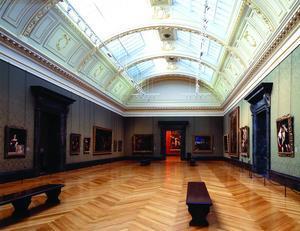To ensure that its artwork remains as well preserved as possible, the National Gallery has invested in a new, high-tech control system.
Any building that is home to one of the greatest collections of European paintings in the world is going to call for some demanding internal environmental conditions. And that is exactly what the building and facilities department of the National Gallery in London has to deliver. It is responsible for maintaining the gallery environment between seasonal temperature limits of 20°C and 23°C +/- 1°C at a relative humidity of 55% +/- 5% with a minimum of short-term variation – a tough task, but one that can be met.
However, having achieved the required room conditions, the department hasn’t become complacent – in fact, it has started to look for areas in which further improvements could be made.
The stability of the controls themselves has been identified as one such area. Any control instability has the potential to create excessive wear and tear on control components, with a potential impact on maintenance costs and operating efficiency. The gallery also thought that it might impact marginally on room conditions.
As a result, the National Gallery initiated a review of the controls – aided by my team at Andrew Reid & Partners – to see if there was any scope for improvement. The review was carried out by the building and facilities department, in conjunction with Kevin Sowerby of Trend Control Systems (for the Wilkins Building) and Sean Osborne of Satchwell Control Systems (for the Sainsbury Wing), who wrote and implemented new software strategies. These strategies looked to incorporate a number of new control philosophies focusing on triple redundancy logic, sensor resolution, PID (proportional plus integral plus derivative) control and humidity control.
Triple redundancy logic
Although modern sensors are more reliable, the TRL concept remains sound. Analysis of the original software logic, however, revealed a problem: if, by chance, the value of the middle sensor is approximately equidistant from the other two, a very small relative drift results in sudden step changes in the TRL value as it jumps between the average of one pair of sensors to the average of another pair. This step change can be considerable if the individual sensor values are some distance apart, resulting in control instability.
The problem is illustrated in figure 1a, which shows that, although the individual temperature sensors in the gallery are quite stable, the TRL value oscillates considerably with consequent impact on the stability of the heating/cooling demand signal (VAV box output).
As a result, in the Wilkins building a revised version of the TRL system, which sought to smooth out these step changes by using a system of weighted averaging of all three sensors, was put in place. Although this was an improvement on the original we felt that further improvements could still be made.
So a new TRL strategy was devised to address these problems and provide a more reliable and consistent indication of gallery environmental conditions. This new logic eschews the concept of averaging sensor values and is based instead on selecting the median sensor as the TRL value, after accounting for any wayward sensors. The result is illustrated in figure 1b and the improvement in terms of stability of the heating/cooling demand signal is evident.
Sensor resolution
Resolution is generally adequate where sensors are directly connected to the building management system outstation that is controlling the plant, but this can worsen considerably when values have to be transmitted between a remote outstation in the gallery and the plant control outstation. To reduce network traffic we found that in this case intercontroller communication had been set to transmit data only when there were significant changes of up to 0.2°C/1% relative humidity or at 10-minute intervals.
This might not sound much in absolute terms but, in the context of room control tolerances of only +/-1°C and +/-5% relative humidity, changes of this order are significant, both representing some 20% of the acceptable deviation.
To use a car analogy, it is a bit like having a five-position accelerator pedal instead of a modulating throttle; you can regulate the car’s speed after a fashion but it’s not going to be a comfortable ride. On investigation we found there was scope to improve the resolution of data transfer between outstations.
PID control
Although both Trend and Satchwell provide PID control loops as a matter of course, we noticed that heating, ventilation and air-conditioning control engineers generally do not use the derivative term. We found that adding a derivative value sometimes allowed the integral time to be reduced, providing tighter control.
There is a recognised problem with PID control loops, known as integral wind-up. This occurs when the set point cannot be achieved and the integral action then winds up the loop output to its maximum. When demand reverses there is then a time lag until control is recovered. An additional strategy was devised to overcome this problem, which effectively removes the necessity to accurately predict upper and lower supply-duct temperature and humidity limits under cascade control. It also reduces temperature/humidity overshoot and undershoot, which can occur on sudden changes of room load, such as when galleries open and close to the public.
Humidity control
In our experience, designers and control engineers tend to treat relative humidity as an entity that can be added or subtracted in much the same way as heat is added or subtracted to change temperature. It is often quoted as if it were an absolute parameter, instead of a relative concept.
To use another car analogy, imagine having a choice of two cars with the same fuel consumption but different fuel tank capacities for a particular journey. If you were told one car has a fuel tank that is 70% full but the other is only 40% full, this would not mean much without knowing the size of the fuel tank in each car. Knowing the absolute amount of fuel available in each car would be much more useful.
We programmed the building management system to calculate the absolute humidity (otherwise known as moisture content or, perhaps more correctly, mixing ratio) and display this on the its supervisor graphic pages to provide a more meaningful indication of ambient humidity and hence external latent load.
The galleries have a net positive humidification demand for most of the year. This is met either by steam injection into the supply air branch ducts or by wet mat humidifiers located in the air handling units.
Steam injection
In accordance with common practice, existing strategy used cascade control, whereby the room’s relative humidity determines the supply air relative humidity set point. This is then controlled by modulating the local branch steam control valve or humidifier.
We felt there were some serious shortcomings with this approach. The first problem is that the relative humidity of supply air is influenced by temperature changes in the supply duct. This has an adverse impact on the stability of the humidity control loop. The second problem is that the supply air relative humidity control band has to cover a wide range, perhaps
85-25% relative humidity as the supply air temperature changes from, say, 15°C in cooling mode to 30°C in heating mode. Short-term variations in supply duct relative humidity to maintain control might typically be only between 65% and 85% relative humidity in cooling mode and 25% to 35% in heating mode. Both represent a relatively small change in relative humidity at opposite ends of the overall control band.
This control arrangement probably derives from the limitations of early pneumatic or simple electronic controls, but modern building control systems are microprocessor-based and can be programmed to calculate the absolute humidity from measurements of temperature and relative humidity.
We thought that if the supply air absolute humidity were controlled instead, this would suit both heating and cooling modes of operation and would remove the influence of supply duct temperature changes.
We then wondered if we could apply a similar approach to room humidity control. This might at first sight appear to be the wrong approach, given that the overriding requirement is to control the room relative humidity. What persuaded us otherwise was considering what control action would be appropriate if the measured room condition was, say, 20°C, 58% relative humidity, compared with a room setpoint of 21°C, 55% relative humidity.
Simply increasing the room temperature would automatically reduce the relative humidity to achieve the set point. Under the existing control strategy, however, there is also a control action to reduce humidifier output as long as relative humidity remains above 55%. If a local steam humidifier is close to its on/off switching threshold, or more notably, if this prompts the opening of the cooling coil control valve to start dehumidifying, this would have a bigger impact on control stability as this would influence the temperature control loop unnecessarily.
We thought a better strategy might be to calculate the room absolute humidity and use this as the process variable for humidity control. We deduced that if both the room temperature and absolute humidity were maintained at their respective set points then the design relative humidity would be obtained by default and overall stability should be improved by removing unnecessary interaction between the two control loops.
A potential downside, however, is that if one or other of these setpoints is not achieved for whatever reason, the resulting relative humidity would be in error. A further strategy was therefore added to compensate as far as possible for any failure to control either temperature or absolute humidity in order to obtain the required room relative humidity.
Wet mat humidifiers
Room humidity is controlled by modulating heating and cooling coils installed upstream of the wet mat humidifiers in order to adjust the leaving air temperature, on the assumption that it will always be close to saturation (dewpoint control). In practice, we found that wet mat saturation efficiency does vary and a better approach was to calculate and control the supply duct absolute humidity in a similar manner to that described above for steam injection systems.
Taking the above example of a room condition of 20°C, 58% relative humidity where the room temperature simply needs to be increased to obtain the desired condition, opening the cooling coil control valve to reduce dewpoint temperature under relative humidity control does not seem the best place to start.
It should be noted, however, that with wet mat systems, room temperature and humidity are inextricably linked unless there is some degree of controlled reheat to separate the two. This is an inherent feature of dewpoint control and any deficiencies in plant sizing that lead to a loss of reheat cannot be overcome simply by controls design.
Analysis
The new TRL strategy was installed in test areas on both Trend and Satchwell systems for six months to check there were no software anomalies before its general adoption. The absolute humidity control philosophy has been tested for more than eight months on a wet mat system and the strategy is now being tested on a steam injection system.
Testing has been carried out under close supervision to ensure the conditions in the gallery are maintained. Figures 2a and 2b show room conditions before and after the new strategy was installed in gallery 29. Humidity control was already generally satisfactory because of the stable nature of wet mat humidifiers, but some improvement in the diurnal variation of room temperature is evident. These graphs span summer and winter seasons so they may not be directly comparable but figure 2b illustrates satisfactory performance of the new software strategy in current ambient conditions. Figures 3a and 3b demonstrate improvement in the stability of the constant hot water valve operation, which was the original point of the exercise.
Following these trials this new control strategy is set to be introduced throughout the gallery. Although developed in the context of museums and art galleries, the principles should apply to any air-conditioning system where close control of environmental conditions is required.
Howard Hall CEng MCIBSE, MIMechE is a mechanical engineer with Andrew Reid & Partners, which has provided design, commissioning and technical support services to the National Gallery since 1990
Downloads
FIGURE 1a: The average of two sensors produces an oscillating TRL value
Other, Size 0 kbFIGURE 1b: Use of the median sensor produces a more stable TRL value
Other, Size 0 kbFIGURE 2a: Conditions before the adoption of the new TRL strategy
Other, Size 0 kbFIGURE 2b: Conditions after the adoption of the new TRL strategy
Other, Size 0 kbFIGURE 3a: Prior stability of the constant hot water valve operation
Other, Size 0 kbFIGURE 3b: New stability of the constant hot water valve operation
Other, Size 0 kb
Source
Building Sustainable Design






















No comments yet